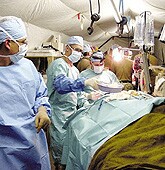
WEDNESDAY, June 1 (HealthDay News) — Using a sophisticated new imaging technique, researchers were able to find previously undetected changes in the brains of Iraq and Afghanistan war veterans who had been diagnosed with mild brain injuries sustained from blast explosions.
Although emphasizing that the researchers are “absolutely not there yet,” Christine Mac Donald, lead author of the study, said that one day this imaging technique “could potentially be utilized to assist a physician in making a diagnosis of traumatic brain injury.”
That, in turn, could help guide therapy and decisions about when a soldier should return to duty, added Mac Donald, who is a research instructor in the department of neurology at Washington University School of Medicine in St. Louis.
But negative scans don’t rule out traumatic brain injury (TBI) as a diagnosis. So, for the time being, diagnoses should be made based on a clinical history, including information on loss of consciousness, memory loss, confusion and other symptoms, the researchers said.
The study findings are published in the June 2 issue of the New England Journal of Medicine.
“The collection of this data is a monumental achievement. Working in the chaos of war, the authors have extracted very high quality data from soldiers exposed to [traumatic brain injury] experiences,” said Keith A. Young, vice chair for research in the department of psychiatry and behavioral science at Texas A&M Health Science Center College of Medicine. “It strikes the right note in pointing us to future diagnostic procedures.”
Blast-related traumatic brain injuries, which have affected some 320,000 troops, are considered the “signature” injury of the Iraq and Afghanistan wars. But there has been some debate over whether some of these milder injuries — concussions — that impose no visible damage can actually damage the brain.
The imaging technique employed for the new study — diffusion tensor imaging, or DTI — looks at how water moves in the brain. Certain patterns of movement indicate that neurons (nerve cells) are damaged or intact.
The study involved 63 U.S. military personnel who had undergone a mild traumatic brain injury in Iraq or Afghanistan who later underwent diffusion tensor imaging in Germany. All had experienced primary blast exposure (due to explosions) and another injury from falling or a vehicular accident.
These people were compared with 21 soldiers who did not have a clinical diagnosis of traumatic brain injury.
The researchers found abnormalities in 29 percent of the patients who had been diagnosed with traumatic brain injury, but not in the control group. And these abnormalities weren’t visible on conventional MRI exams.
The anomalies linked to explosive blasts were different from those seen in civilians with mild brain trauma caused by falls, sports injuries, car accidents and blows to the head. The abnormalities changed over time but were still visible a year later, the study authors said.
But at this point it’s not clear whether the abnormalities mean the brain has been damaged.
“The importance of this study is that it clearly delineates DTI [diffusion tensor imaging] as a valuable MRI procedure with potential to tell us about brain damage related to TBI [traumatic brain injury],” said Young, who is core leader for neuroimaging and genetics at the Center of Excellence for Research on Returning War Veterans in Temple, Texas. “We just have to figure out what DTI is telling us.”
A letter to the editor in the same issue of the journal said eye injuries suffered by soldiers in the Iraq and Afghanistan wars may be going undetected.
That conclusion was based on examinations of 46 veterans who had been injured in a blast explosion and who also had traumatic brain injury. Eye injuries were found in 43 percent of the group.
The letter authors recommended that soldiers undergo extensive eye exams upon returning from a war zone.
More information
The U.S. National Institutes of Health has more on traumatic brain injury.

